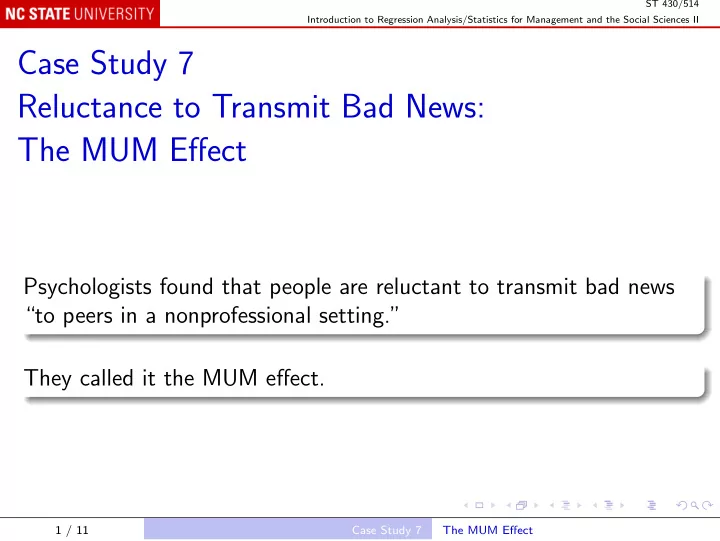

ST 430/514 Introduction to Regression Analysis/Statistics for Management and the Social Sciences II Case Study 7 Reluctance to Transmit Bad News: The MUM Effect Psychologists found that people are reluctant to transmit bad news “to peers in a nonprofessional setting.” They called it the MUM effect. 1 / 11 Case Study 7 The MUM Effect
ST 430/514 Introduction to Regression Analysis/Statistics for Management and the Social Sciences II Two theories about the cause: aversion to private discomfort: To avoid discomforts such as empathy with the victim’s distress, or guilt feelings for their own good fortune, would-be communicators of bad news keep mum. public display: People experience little or no discomfort when transmitting bad news, but keep mum to avoid an unfavorable impression, or to pay homage to a social norm. 2 / 11 Case Study 7 The MUM Effect
ST 430/514 Introduction to Regression Analysis/Statistics for Management and the Social Sciences II An experiment Forty subjects (Duke undergrads) each administered an IQ test to another student, and informed the test-taker of the percentile score. Two experimental factors: subject visibility: Some subjects were told the test-taker could see them, some were told the test-taker could not see them. confederate success: The subjects were given one of two answer keys; one placed the test-taker in the top 20% of Duke undergrads, the other in the bottom 20%. The response is the latency to feedback : time between the end of the test and delivery of the result. 3 / 11 Case Study 7 The MUM Effect
ST 430/514 Introduction to Regression Analysis/Statistics for Management and the Social Sciences II Completely Randomized 2 × 2 Factorial Design The subjects were randomly assigned to 4 groups of 10 subjects. Get the data and plot them: mum <- read.table("Text/Cases/MUM.txt", header = TRUE) plot(FEEDBACK ~ SUBJECT + CONFED, mum) with(mum, interaction.plot(SUBJECT, CONFED, FEEDBACK)) with(mum, interaction.plot(CONFED, SUBJECT, FEEDBACK)) The interaction plots suggest that the factors interact, so we will fit the complete model, which includes their interaction, to test whether this graphical indication is supported. 4 / 11 Case Study 7 The MUM Effect
ST 430/514 Introduction to Regression Analysis/Statistics for Management and the Social Sciences II The complete model (two qualitative factors): E ( Y ) = β 0 + β 1 x 1 + β 2 x 2 + β 3 x 1 x 2 , where x 1 and x 2 are indicator variables for subject visibility and confederate outcome. Analysis of Variance summary(aov(FEEDBACK ~ SUBJECT * CONFED, mum)) 5 / 11 Case Study 7 The MUM Effect
ST 430/514 Introduction to Regression Analysis/Statistics for Management and the Social Sciences II Output Df Sum Sq Mean Sq F value Pr(>F) SUBJECT 1 8381 8381 25.5 1.29e-05 *** CONFED 1 8151 8151 24.8 1.60e-05 *** SUBJECT:CONFED 1 20839 20839 63.4 1.87e-09 *** Residuals 36 11834 329 --- Signif. codes: 0 *** 0.001 ** 0.01 * 0.05 . 0.1 1 The output confirms that the interaction term is important, supporting the indication from the interaction plots. 6 / 11 Case Study 7 The MUM Effect
ST 430/514 Introduction to Regression Analysis/Statistics for Management and the Social Sciences II The interaction plots also suggested that three of the treatment means are about equal, and only the fourth is different. Use Tukey’s Honest Significant Difference TukeyHSD(aov(FEEDBACK ~ SUBJECT : CONFED, mum)) 7 / 11 Case Study 7 The MUM Effect
ST 430/514 Introduction to Regression Analysis/Statistics for Management and the Social Sciences II Output Tukey multiple comparisons of means 95% family-wise confidence level Fit: aov(formula = FEEDBACK ~ SUBJECT:CONFED, data = mum) $‘SUBJECT:CONFED‘ diff lwr upr p adj Visible:Failure-NotVis:Failure 74.6 52.762797 96.437203 0.0000000 NotVis:Success-NotVis:Failure 17.1 -4.737203 38.937203 0.1696195 Visible:Success-NotVis:Failure 0.4 -21.437203 22.237203 0.9999560 NotVis:Success-Visible:Failure -57.5 -79.337203 -35.662797 0.0000001 Visible:Success-Visible:Failure -74.2 -96.037203 -52.362797 0.0000000 Visible:Success-NotVis:Success -16.7 -38.537203 5.137203 0.1858161 8 / 11 Case Study 7 The MUM Effect
ST 430/514 Introduction to Regression Analysis/Statistics for Management and the Social Sciences II Note that Visible:Failure is significantly higher than NotVis:Failure , NotVis:Success , and Visible:Success . Also, there are no significant differences among NotVis:Failure , NotVis:Success , and Visible:Success . See the treatment means: summary(lm(FEEDBACK ~ 0 + SUBJECT : CONFED, mum)) 9 / 11 Case Study 7 The MUM Effect
ST 430/514 Introduction to Regression Analysis/Statistics for Management and the Social Sciences II Output Call: lm(formula = FEEDBACK ~ 0 + SUBJECT:CONFED, data = mum) Residuals: Min 1Q Median 3Q Max -35.20 -10.22 3.75 11.75 31.40 Coefficients: Estimate Std. Error t value Pr(>|t|) SUBJECTNotVis:CONFEDFailure 72.200 5.733 12.59 9.38e-15 *** SUBJECTVisible:CONFEDFailure 146.800 5.733 25.61 < 2e-16 *** SUBJECTNotVis:CONFEDSuccess 89.300 5.733 15.58 < 2e-16 *** SUBJECTVisible:CONFEDSuccess 72.600 5.733 12.66 7.97e-15 *** --- Signif. codes: 0 *** 0.001 ** 0.01 * 0.05 . 0.1 1 Residual standard error: 18.13 on 36 degrees of freedom Multiple R-squared: 0.9713, Adjusted R-squared: 0.9681 F-statistic: 304.3 on 4 and 36 DF, p-value: < 2.2e-16 10 / 11 Case Study 7 The MUM Effect
ST 430/514 Introduction to Regression Analysis/Statistics for Management and the Social Sciences II Conclusion The subjects took essentially the same amount of time to pass the result to the test-taker in all situations, except that they took significantly longer, roughly twice as long, to inform the test-taker about a poor performance when visible to the test-taker. That is not entirely consistent with either theory. 11 / 11 Case Study 7 The MUM Effect
Recommend
More recommend